Comments / Questions (63)
![]() Chantal wrote:
Chantal wrote:
Bonjour Comment faire les augmentations des manches avec un point de ble ? Après avoir terminé mes augmentations, je ne peux plus reconstituer le point. Je tombe toujours sur deux mailles endroit ou de mailles envers Merci pour votre réponse Cordialement
07.01.2025 - 09:25DROPS Design answered:
Bonjour Chantal, tricotez les nouvelles mailles en fonction de la maille suivante ou précédente, autrement dit, si la maille précédente/la maille suivante doit être tricotée à l'endroit, tricotez la nouvelle maille à l'envers et vice versa - ainsi, le point de blé restera bien en continu. Bon tricot!
07.01.2025 - 13:27
![]() Jutta wrote:
Jutta wrote:
Warum werden die Raglanschrägen nicht an den Übergängen von Ärmel zu Vorder- Rückenteil gestrickt, sondern mitten in den Teilen?
01.12.2024 - 15:39DROPS Design answered:
Liebe Jutta, das ist wahrscheinlich Designerin's Wahl je nach Modell und Muster. Aber die Verteilung entsteht nicht mitten in den Teilen, nur nicht genau wie bei den jeweiligen Stücke. Viel Spaß beim Stricken!
02.12.2024 - 10:04
![]() Jutta wrote:
Jutta wrote:
Nach dem Abketten des Armausschnittes beim Ärmel habe ich bei L noch 72 Maschen übrig, soll aber in der ersten Reihe des gesamten Teiles 80 Maschen Ärmel stricken. Wo kommen die 8 Maschen her?
30.11.2024 - 12:29
![]() Ute wrote:
Ute wrote:
Ich stricke aber L. Da wird die Passe ja deutlich kürzer.
28.10.2024 - 15:21
![]() Ute wrote:
Ute wrote:
Ich wundere mich über die 37 cm Länge bis unter dem Arm. Viele andere Pullover werden 43-44 cm lang gestrickt. Vom Bild kommt er mir auch deutlich länger vor. Ist die Angabe richtig?
27.10.2024 - 16:57DROPS Design answered:
Liebe Ute, die Länge der Passe kommt noch dazu für die fertige gesamte Länge - z.B. in 3XL: 30 cm Passe + 5 cm Schulter + 37 cm Rumpfteil sind insgesamt 72 cm. Viel Spaß beim Stricken!
28.10.2024 - 10:14
![]() Olivia Ljungdahl wrote:
Olivia Ljungdahl wrote:
M: uppläggning 234m, ökar med (4+1+8+1+4 = 18m) det femte varvet enligt diagram (totalt 252m) Nästa steg: Framsidan (24+14+4+34+4+14+24 = 118m), sen står det att jag ska sticka de resterande 96m i mosstickning men det är 252-118 = 134 maskor kvar. Fel i mönstret? Några Tips eller förklaringar som kan hjälpa?
16.10.2024 - 15:01DROPS Design answered:
Hej Olivia. Innan du byter till rundsticka 4,5 och stickar mönster står det om minskningar du ska göra. I storlek M minskar du 6+6+26 maskor, så om du gör det så stämmer det. Mvh DROPS Design
17.10.2024 - 07:34
![]() Ute wrote:
Ute wrote:
Wie viele Knäuel Wolle brauche ich, wenn ich Größe XL in doppelter Alpaka stricken möchte?
24.09.2024 - 13:33DROPS Design answered:
Liebe Ute, Alpaca gehört der Garngruppe A, dieser Pullover wird mit einem Faden der Garngruppe B gestrickt, benutzen Sie den Garnumrechner um die Garnalternative sowie die passende Garnmenge zu finden. Oder hier finden Sie Anleitungen, die Sie mit 2 Fäden Alpaca stricken können (Garnumrechner wird Ihnen auch hier helfen). Viel Spaß beim Stricken!
25.09.2024 - 08:05
![]() Sylvie Guertault wrote:
Sylvie Guertault wrote:
Je vous remercie pour votre réponse. Par contre je bloque toujours car vous dites que sur les 96m du dos, j'en tricote 4 qui seront pour la manche (reste donc 92m pour le dos), puis les 84m suivantes pour le dos, il reste 4 m qui sont pour la manche. Dans mon tricot, il restera 8m et non 4 (92 - 84=8) Merci de m'expliquer, car je ne comprends toujours pas.
21.06.2024 - 16:37DROPS Design answered:
Bonjour Mme Guertault, le décompte précédent était faux, pour le dos vous devez avoir 92 mailles après la séparation (96 m après les côtes + 2 x 4 augmentations - 2 x 6 m rabattues pour les emmanchures); les 4 premières mailles du dos sont pour la manche droite et les 4 dernières mailles du dos sont pour la manche gauche, il reste bien 84 mailles pour le dos; Bon tricot!
24.06.2024 - 09:45
![]() Birgitte wrote:
Birgitte wrote:
Hej drops. Strikker xxl Markering på bærestykke driller. For 130 m Bag 130 m Ærme 78m Ærme 78 m Ialt 416 så lang så godt. Kan ikke få inddeling af markerings tråde for indtagning til at passe. Skal der være 130 foran og kun 106 på ryggen? Skal de 12 m på hvert ærme tages fra ryggens masker? Passer det at det kun er 6 m man skal strikke når bærestykke startes? Jeg har kæmpet i flere timer. Håber på hjælp. Mvh Birgitte
17.06.2024 - 13:15DROPS Design answered:
Hei Birgitte. Det er ikke fletter på bakstykket, slik at det er flere masker på forstykket (flettene trekker arbeidet sammen). Når du strikker forstykket, bakstykket og ermene sammen går noen masker fra forstykket og bakstrykket til ermer. Start i overgangen etter ermet og før bolen på bakstykket og strikk mønster som før: Strikk 6 masker (litt av 1.erme), sett en merketråd her, strikk 106 masker (= bakstykket), sett en merketråd her, strikk 6+78+6 masker (=2.erme), sett en merketråd her, strikk 130 masker (= forstykket), sett en merketråd her, strikk 6+78 masker (= resten av 1.erme). Husk du startet med 6 masker og starten er etter disse 6 maskene. mvh DROPS Design
24.06.2024 - 14:35
![]() Birgitte wrote:
Birgitte wrote:
Test
17.06.2024 - 13:09
Aure#auresweater |
|||||||||||||||||||||||||
 |
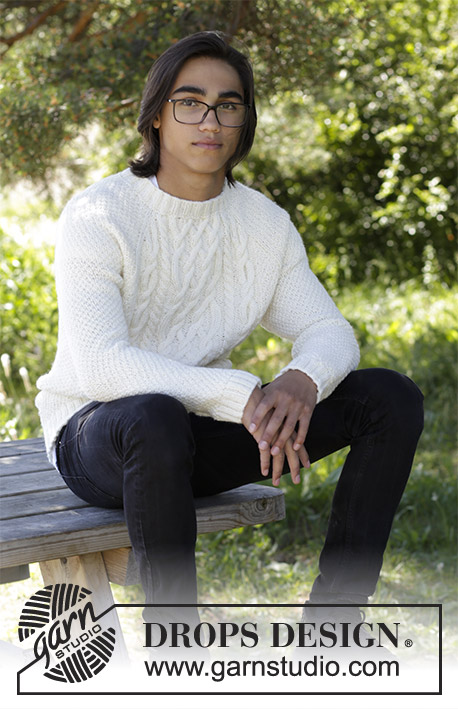 |
||||||||||||||||||||||||
Knitted jumper with raglan and cables for men. Size: S - XXXL Piece is knitted in DROPS Karisma or Sky.
DROPS 185-9 |
|||||||||||||||||||||||||
|
INFORMATION FOR PATTERN: PATTERN: See diagram A.1 to A.6 (diagrams A.2 and A.6 only applies to size XL, XXL and XXXL). Diagrams show all rows in pattern seen from the right side. INCREASE TIP (applies to sides on body and under sleeve): Work until 1 stitch remains before marker thread, 1 yarn over, knit 2 A.1 as before (marker thread is in the middle of these 2 stitches), 1 yarn over. On next round purl/knit yarn over twisted and work the new stitches in A.1. RAGLAN: Work until 3 stitches remain before marker thread. Purl 2 together, knit 2 (marker thread is in the middle of these 2 stitches), purl 2 together. Repeat decease at each of the remaining marker threads (= 8 stitches decreased on round). DECREASE/INCREASE TIP (evenly): To calculate how to decrease/increase evenly, use the number of stitches decreases/increases are done over (e.g. 26 stitches) and divide stitches by number of decreases/increases to be done (e.g. 6) = 4.3. In this example knit approx. every 3rd and 4th stitch together. When increasing stitches make (in this example) 1 yarn over after approx. every 4th stitch. On next round work yarn over twisted to avoid hole. ---------------------------------------------------------- JUMPER: Body is worked in the round on circular needle, bottom up. Work cables on front piece and moss stitch in the sides, on back piece and on sleeves. Work sleeves in the round on double pointed needles. NOTE: Size XL, XXL and XXXL have one small cable (= A.2/A.6) more towards each side than model on picture. BODY: Cast on 218-234-254-276-304-328 stitches on circular needle size 3.5 mm with Karisma or Sky. Knit 1 round. Insert 1 marker thread at the beginning of the round (= side). Now work rib in the different sizes as follows: SIZE S, M AND L: Work (knit 2, purl 2) over the first 24-28-32 stitches, knit 2, A.3a (= 10 stitches), A.4a (= 3 stitches), A.5a (= 26 stitches), A.4a, A.3a, work (knit 2, purl 2) over the remaining 140-152-168 stitches. SIZE XL, XXL AND XXXL: Work (knit 2, purl 2) over the first 32-40-44 stitches, knit 2, work A.2a (= 5 stitches), A.3a (= 10 stitches), A.4a (= 3 stitches), A.5a (= 26 stitches), A.4a, A.3a, A.6a (= 5 stitches), work (knit 2, purl 2) over the remaining 180-200-220 stitches. Continue like this and repeat the first 3 rounds in diagrams until rib measures 5 cm. Work next round as follows: Knit the first 26-30-34-34-42-46 stitches and decrease at the same time 6-6-6-8-8-8 stitches evenly – read DECREASE/INCREASE TIP, work last row in diagrams over the next 52-52-52-62-62-62 stitches, knit the next 26-30-34-34-42-46 stitches and decrease at the same time 6-6-6-8-8-8 stitches evenly, knit the remaining stitches on round and decrease at the same time 26-26-30-32-32-36 stitches evenly = 198-214-230-248-276-296 stitches. Switch to circular needle size 4.5 mm. Now work pattern in the different sizes as follows: SIZE S, M AND L: (marker in the side is here = beginning of round), work A.1 (= 2 stitches) over the first 20-24-28 stitches, A.3b (= 14 stitches), A.4b (= 4 stitches), A.5b (= 34 stitches), A.4b, A.3b, A.1 over the next 20-24-28 stitches, insert a marker thread here (= the other side), work A.1 over the next 88-96-104 stitches. SIZE XL, XXL and XXXL: (marker in the side is here = beginning of round), work A.1 (= 2 stitches) over the first 26-34-38 stitches, A.2b (= 6 stitches), A.3b (= 14 stitches), A.4b (= 4 stitches), A.5b (= 34 stitches), A.4b, A.3b, A.6b (= 6 stitches), A.1 over the next 26-34-38 stitches, insert a marker thread here (= the other side), work A.1 over the next 114-126-138 stitches. Continue pattern in the round like this. REMEMBER THE KNITTING TENSION! When piece measures 8-8-8-9-9-9 cm, increase 2 stitches on each side – read INCREASE TIP. Increase like this every 8 cm 4 times in total = 214-230-246-264-292-312 stitches. REMEMBER THE KNITTING TENSION! When piece measures 36-36-37-37-37-37 cm, work one round while casting off 12-12-14-14-16-18 stitches under each sleeve for armhole (= 6-6-7-7-8-9 stitches on each side of marker thread in each side = 190-206-218-236-260-276 stitches on round. Cut the yarn. Put piece aside and work the sleeves. SLEEVES: Work sleeves in the round on double pointed needles. Cast on 56-60-60-64-64-68 stitches on double pointed needles size 3.5 mm with Karisma. Work rib (knit 2/purl 2) for 5 cm. Knit 1 round while decreasing 14-16-14-16-14-16 stitches evenly = 42-44-46-48-50-52 stitches. Switch to double pointed needles size 4.5 mm. Insert a marker thread at beginning of round. Work diagram A.1 in the round. When sleeve measures 5-7-6-11-9-7 cm from cast-on edge, increase 1 stitch on each side of marker thread mid under sleeve (= 2 stitches increased) - remember INCREASE TIP. Increase like this every 8th-6th-5th-4th-4th-4th round 14-17-20-21-22-23 times in total = 70-78-86-90-94-98 stitches. When sleeve measures 49-48-47-46-45-45 cm (NOTE: Shorter measurements in the larger sizes because of longer yoke), cast off the middle 12-12-14-14-16-18 stitches under sleeve (i.e. cast off 6-6-7-7-8-9 stitches on each side of marker thread) = 58-66-72-76-78-80 stitches remain. Put piece aside and knit another sleeve. YOKE: Slip sleeves on to same circular needle as body where armholes were cast off = 306-338-362-388-416-436 stitches. NOW MEASURE PIECE FROM HERE! Begin in transition after sleeve and before body on back piece and work pattern as before as follows: Work 4-4-4-4-6-8 stitches, insert a marker thread here (NOTE: this is the beginning of round onwards), work 76-84-90-100-106-112 stitches (= back piece), insert a marker thread here, work 66-74-80-84-90-96 stitches (= sleeve), insert a marker thread here, work 98-106-112-120-130-132 stitches (= front piece), insert a marker thread here, work 66-74-80-84-90-96 stitches (= sleeve). Continue pattern as before and knit 1 stitch on each side of the 4 marker threads in piece. On next round begin decrease for RAGLAN – see explanation above. Decrease like this every 4th round 3-2-0-0-0-0 times and every other round 20-25-30-32-35-38 times (a total of 23-27-30-32-35-38 rounds with deceases) = 122-122-122-132-136-132 stitches. When decreasing for raglan and there are not enough stitches to work cables on front piece, work knit over knit and purl over purl. When all decreases are done, the piece measures approx. 21-23-24-26-28-30 cm. Knit over stitches on back piece, knit over the remaining stitches (the 2 sleeves and front piece) and decrease at the same time 22-22-22-16-16-12 stitches evenly = 100-100-100-116-120-120 stitches. NECK EDGE: Switch to a short circular needle size 3.5 mm. Purl 1 round. Knit 1 round while increasing 8-8-12-8-8-8 stitches evenly - remember INCREASE TIP = 108-108-112-124-128-128 stitches. Purl 1 round and knit 1 round. Work rib (knit 2/purl 2) for 3 cm. Cast off stitches with knit over knit and purl over purl. Fasten off. ASSEMBLY: Sew the openings under the sleeves. |
|||||||||||||||||||||||||
Diagram explanations |
|||||||||||||||||||||||||
|
|||||||||||||||||||||||||
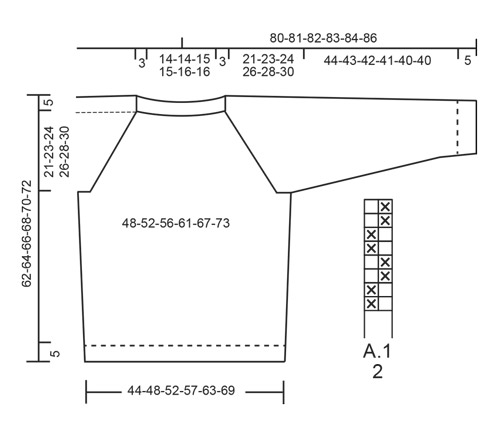 |
|||||||||||||||||||||||||
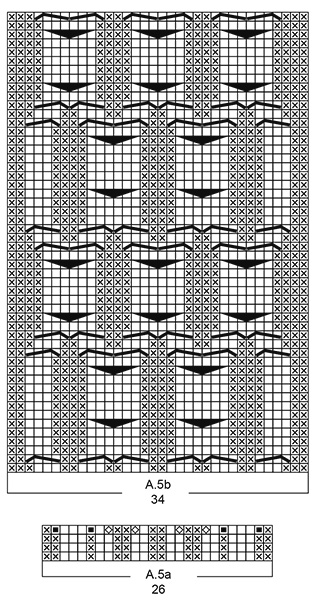 |
|||||||||||||||||||||||||
 |
|||||||||||||||||||||||||
 |
|||||||||||||||||||||||||
Have you finished this pattern?Tag your pictures with #dropspattern #auresweater or submit them to the #dropsfan gallery. Do you need help with this pattern?You'll find 28 tutorial videos, a Comments/Questions area and more by visiting the pattern on garnstudio.com. © 1982-2025 DROPS Design A/S. We reserve all rights. This document, including all its sub-sections, has copyrights. Read more about what you can do with our patterns at the bottom of each pattern on our site. |
|||||||||||||||||||||||||







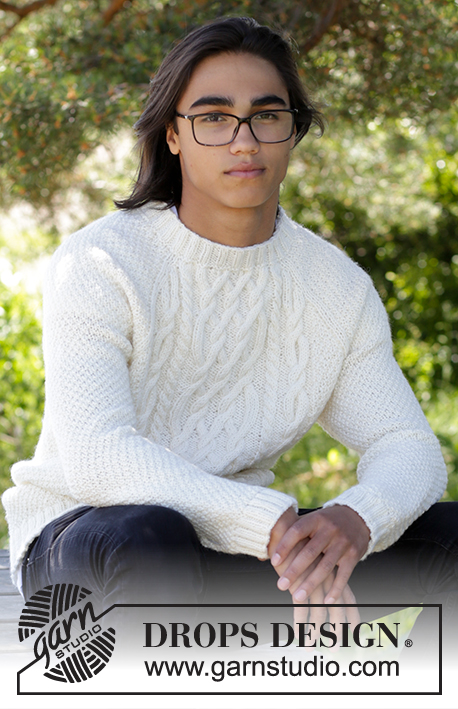
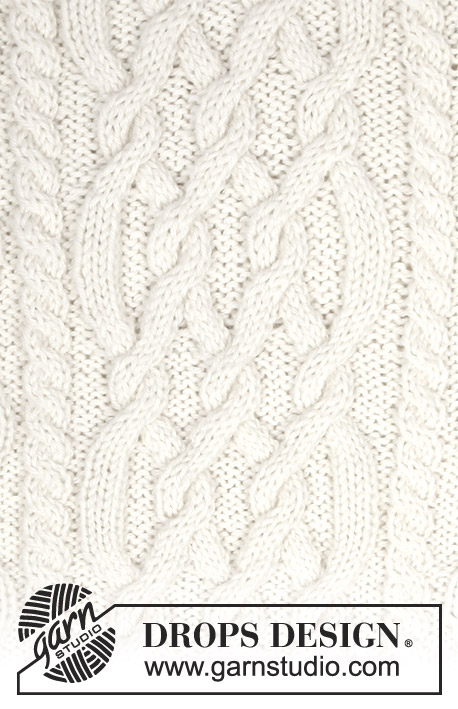

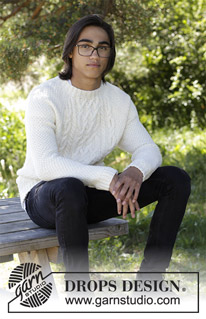
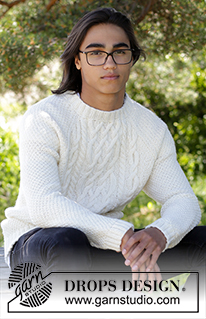










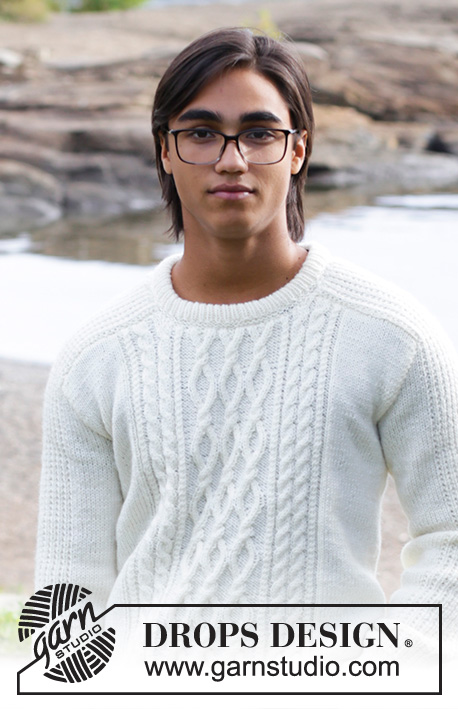























































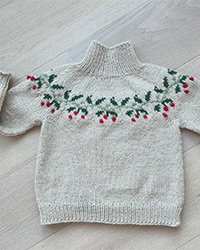
Post a comment to pattern DROPS 185-9
We would love to hear what you have to say about this pattern!
If you want to leave a question, please make sure you select the correct category in the form below, to speed up the answering process. Required fields are marked *.